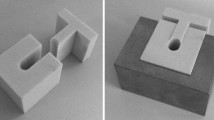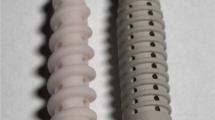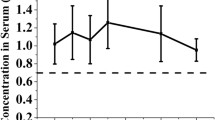Abstract
Purpose
Fixation of soft tissue grafts with interference screws relies on the friction of the graft between the screw and the bone tunnel. The goal of this study was to precondition such grafts by mechanical compression in order to reduce anticipated and undesired viscoelastic adaptation of the graft to screw pressure. Further, the otherwise slippery graft surface was modified with impressed tricalcium phosphate granules (TCP) to improve friction and mechanical hold.
Methods
Fresh flexor digitorum tendons from young bovines were used to create bundles with a diameter of 8–9 mm and were divided into 10 groups to compare the pullout strength and bone damage in a variety of construct scenarios. Specifically, the effects of graft precompression to reduce preimplantation graft diameter were investigated. Further the effects of impressing TCP granules and/or a screw thread into the tendon surface during the compression process were studied.
Results
In sawbone tests, radial graft compression allowed for a smaller bone tunnel (7 mm), but resulted in a significantly lower pullout strength of 174 N (95% CI: 97, 250), compared with controls [315 N (204, 426)]. In contrast, TCP coated [402 N (243, 561)], screw embossed grafts [458 N (302, 614)], and the combination of TCP and embossing [409 N (274, 543)] achieved higher pullout strengths when compared to the standard technique. In porcine bone, untreated grafts using an 8 mm screw pulled out at 694 ± 93 N, significantly higher loads were required to pullout compressed grafts with or without TCP coating (870 ± 74 and 878 ± 131 N), yet fixed with a 7 mm screw.
Conclusion
Modification of the tendon graft surface has a large influence on the biomechanical performance of interference screw fixation and results in less bone damage inflicted during insertion to a smaller tunnel diameter, while simultaneously achieving superior pullout strength.





Similar content being viewed by others
References
Becker R, Voigt D, Starke C et al (2001) Biomechanical properties of quadruple tendon and patellar tendon femoral fixation techniques. Knee Surg Sports Traumatol Arthrosc 9:337–342
Donahue TL, Gregersen C, Hull ML et al (2001) Comparison of viscoelastic, structural, and material properties of double-looped anterior cruciate ligament grafts made from bovine digital extensor and human hamstring tendons. J Biomech Eng 123:162–169
Drogset JO, Strand T, Uppheim G et al (2010) Autologous patellar tendon and quadrupled hamstring grafts in anterior cruciate ligament reconstruction: a prospective randomized multicenter review of different fixation methods. Knee Surg Sports Traumatol Arthrosc 18:1085–1093
Drogset JO, Straume LG, Bjorkmo I et al (2011) A prospective randomized study of acl-reconstructions using bone-patellar tendon-bone grafts fixed with bioabsorbable or metal interference screws. Knee Surg Sports Traumatol Arthrosc 19:753–759
Fabbriciani C, Mulas PD, Ziranu F et al (2005) Mechanical analysis of fixation methods for anterior cruciate ligament reconstruction with hamstring tendon graft. An experimental study in sheep knees. Knee 12:135–138
Giurea M, Zorilla P, Amis AA et al (1999) Comparative pull-out and cyclic-loading strength tests of anchorage of hamstring tendon grafts in anterior cruciate ligament reconstruction. Am J Sports Med 27:621–625
Halewood C, Hirschmann MT, Newman S et al (2011) The fixation strength of a novel acl soft-tissue graft fixation device compared with conventional interference screws: a biomechanical study in vitro. Knee Surg Sports Traumatol Arthrosc 19:559–567
Jarvinen TL, Nurmi JT, Sievanen H (2004) Bone density and insertion torque as predictors of anterior cruciate ligament graft fixation strength. Am J Sports Med 32:1421–1429
Micucci CJ, Frank DA, Kompel J et al (2010) The effect of interference screw diameter on fixation of soft-tissue grafts in anterior cruciate ligament reconstruction. Arthroscopy 26:1105–1110
Nebelung W, Becker R, Urbach D et al (2003) Histological findings of tendon-bone healing following anterior cruciate ligament reconstruction with hamstring grafts. Arch Orthop Trauma Surg 123:158–163
Nyland J, Kocabey Y, Caborn DN (2004) Insertion torque pullout strength relationship of soft tissue tendon graft tibia tunnel fixation with a bioabsorbable interference screw. Arthroscopy 20:379–384
Colvin A, Sharma C, Parides M et al (2011) What is the best femoral fixation of hamstring autografts in anterior cruciate ligament reconstruction?: a meta-analysis. Clin Orthop Relat Res 469:1075–1081
Reigstad O, Franke-Stenport V, Johansson CB et al (2007) Improved bone ingrowth and fixation with a thin calcium phosphate coating intended for complete resorption. J Biomed Mater Res B Appl Biomater 83:9–15
Roy S, Fernhout M, Stanley R et al (2010) Tibial interference screw fixation in anterior cruciate ligament reconstruction with and without autograft bone augmentation. Arthroscopy 26:949–956
Shen PH, Lien SB, Shen HC et al (2009) Comparison of different sizes of bioabsorbable interference screws for anterior cruciate ligament reconstruction using bioabsorbable bead augmentation in a porcine model. Arthroscopy 25:1101–1107
Sim JA, Kwak JH, Yang SH et al (2009) Comparative biomechanical study of the ligament plate and other fixation devices in acl reconstruction. Int Orthop 33:1269–1274
Weimann A, Rodieck M, Zantop T et al (2005) Primary stability of hamstring graft fixation with biodegradable suspension versus interference screws. Arthroscopy 21:266–274
Wen CY, Qin L, Lee KM et al (2009) The use of brushite calcium phosphate cement for enhancement of bone-tendon integration in an anterior cruciate ligament reconstruction rabbit model. J Biomed Mater Res B Appl Biomater 89B:466–474
Zantop T, Kubo S, Petersen W et al (2007) Current techniques in anatomic anterior cruciate ligament reconstruction. Arthroscopy 23:938–947
Conflict of interest
The following authors have claimed intellectual property ownership related to the manuscript content: Mazda Farshad, Jess G. Snedeker, Dominik C. Meyer, but have no other conflicts of interest to disclose.
Author information
Authors and Affiliations
Corresponding author
Rights and permissions
About this article
Cite this article
Farshad, M., Weinert-Aplin, R.A., Stalder, M. et al. Embossing of a screw thread and TCP granules enhances the fixation strength of compressed ACL grafts with interference screws. Knee Surg Sports Traumatol Arthrosc 20, 268–274 (2012). https://doi.org/10.1007/s00167-011-1623-9
Received:
Accepted:
Published:
Issue Date:
DOI: https://doi.org/10.1007/s00167-011-1623-9




